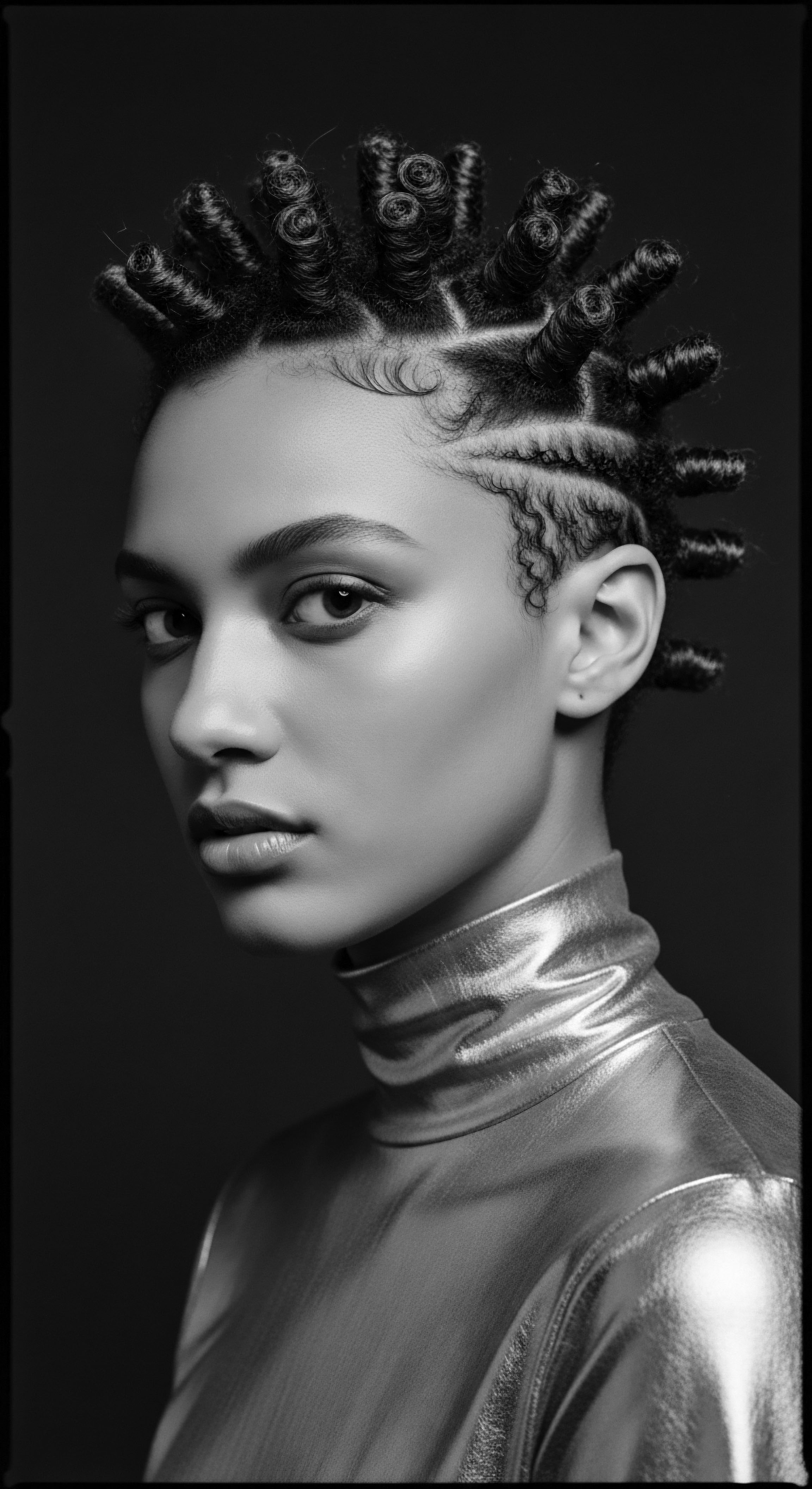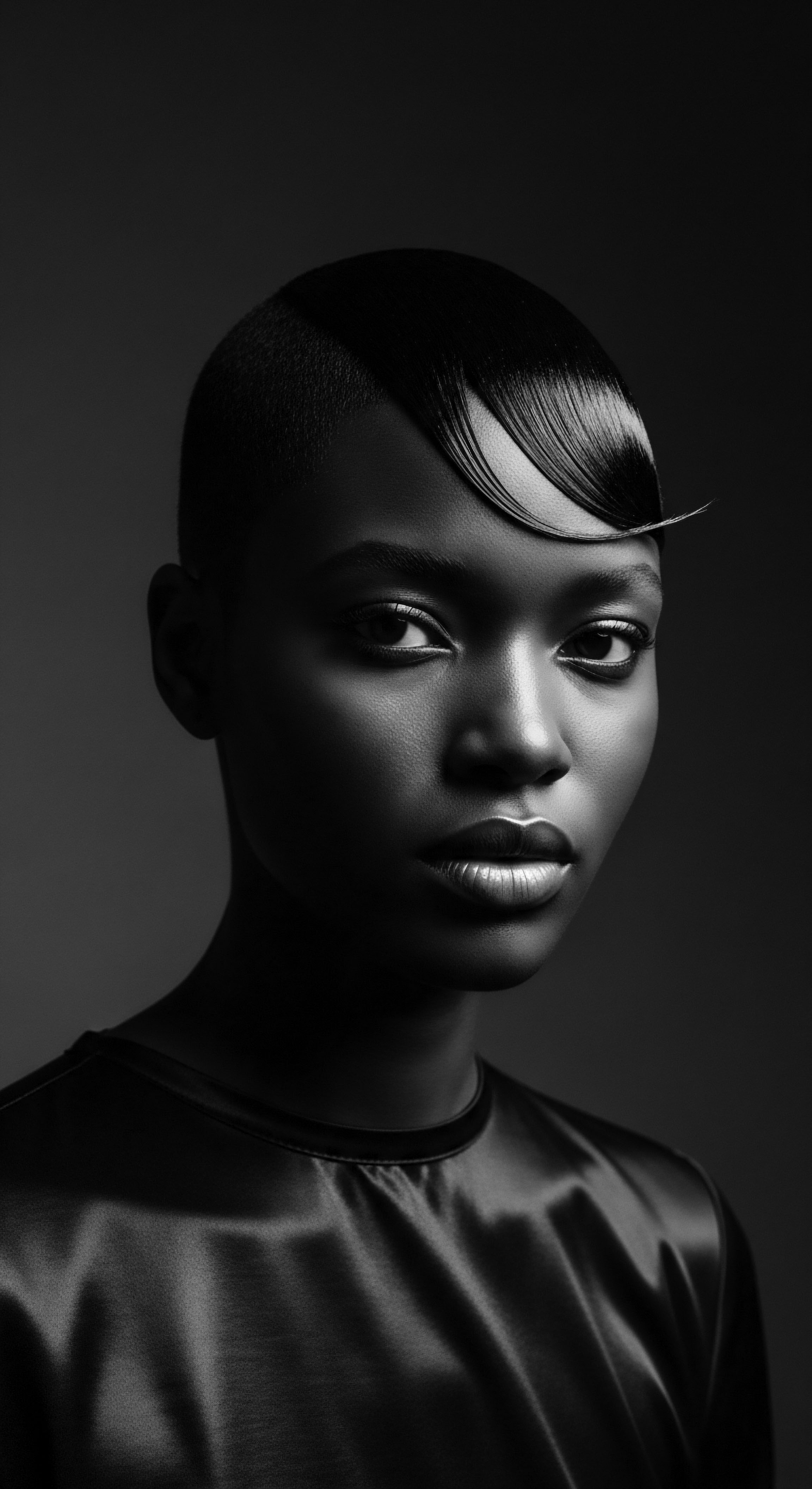
Fundamentals
Botanical Innovation, when considered through the lens of Roothea, represents the continuous discovery and application of plant-derived wisdom for the care and adornment of textured hair. It traces a profound connection between the elemental biology of plants and the historical practices that have shaped hair traditions across generations. This foundational understanding begins with recognizing plants not simply as ingredients, but as living sources of compounds that interact with hair and scalp, offering benefits rooted in efficacy and historical precedent.
From the earliest moments of human existence, individuals observed the natural world, discerning which leaves, roots, barks, and seeds offered cleansing, soothing, protective, or strengthening properties. This observation laid the groundwork for what we now identify as botanical advancements. For textured hair, often characterized by its unique coiled structures and varied porosity, these plant-based approaches have always been more than mere cosmetic applications. They embodied a living pharmacy, a connection to the earth, and a quiet affirmation of resilience, particularly within communities whose historical journeys demanded ingenuity and resourcefulness.
Botanical Innovation reflects an ancient dialogue between human needs and the earth’s offerings, particularly significant for the ancestral care of textured hair.
- Direct Plant Use ❉ Employing plant parts directly, such as aloe vera pulp or fresh hibiscus leaves, for their immediate properties.
- Infusions and Decoctions ❉ Extracting beneficial compounds by steeping plants in water, creating liquids for rinses or sprays.
- Oils and Butters ❉ Pressing seeds or nuts to yield nourishing emollients like shea butter or coconut oil, staples in textured hair care.
- Clays and Earth Minerals ❉ Utilizing natural earth elements, often infused with botanicals, for cleansing or conditioning.
| Botanical Source Aloe Vera (Aloe barbadensis miller) |
| Traditional Use Soothing scalp ailments, detangling aid |
| Basic Hair Benefit Moisture, anti-inflammatory action |
| Botanical Source Shea Butter (Vitellaria paradoxa) |
| Traditional Use Deep conditioning, scalp protection |
| Basic Hair Benefit Softness, barrier enhancement |
| Botanical Source Hibiscus (Hibiscus rosa-sinensis) |
| Traditional Use Hair softening, color enhancement |
| Basic Hair Benefit Conditioning, gloss |
| Botanical Source Nettle (Urtica dioica) |
| Traditional Use Scalp stimulation, hair rinse |
| Basic Hair Benefit Circulation, perceived strengthening |
| Botanical Source These plant gifts represent the foundational wisdom from which all subsequent botanical exploration has grown, shaping the earliest hair rituals. |

Intermediate
Moving beyond the simplest applications, an intermediate grasp of Botanical Innovation unveils the intricate relationships between plant biochemistry and the unique architecture of textured hair. This deeper appreciation acknowledges that the efficacy of ancestral practices often stemmed from an intuitive yet profound understanding of active plant compounds. Hair, a resilient protein fiber, responds to specific molecular structures found within botanicals, affecting its elasticity, moisture retention, and overall vitality. The coiled nature of textured strands, with their often exposed cuticles, requires thoughtful approaches to minimize breakage and preserve inherent strength.
Across diverse Black and mixed-race communities, a legacy of botanical insight evolved, passed through oral traditions and hands-on demonstrations. This communal transmission safeguarded knowledge about preparing plant matter to maximize its benefits. Generations learned to identify plants that offered humectant properties, drawing moisture into the hair, or those providing occlusive barriers, sealing hydration within the strand.
The wisdom extended to understanding how to blend different botanical elements to achieve a synergistic effect, where the combined impact surpassed that of individual components. This collective repository of information, carefully tended over centuries, formed a practical science, adapting to new environments and available flora.
The historical application of plant knowledge for textured hair reveals an intricate interplay between traditional wisdom and the biomechanical needs of the hair strand.
- Humectants ❉ Ingredients like vegetable glycerin or honey, derived from plants or plant-related processes, draw moisture from the air.
- Emollients ❉ Plant oils and butters, such as jojoba oil or mango butter, smooth and soften the hair cuticle, adding suppleness.
- Protein Reinforcers ❉ Plant-based proteins, for example, from rice or wheat, offer temporary reinforcement to the hair’s protein structure, assisting in reducing breakage.
- Anti-Inflammatories ❉ Botanicals like chamomile or calendula possess compounds that can calm scalp irritation, promoting a healthy environment for hair growth.
The understanding of how to extract, combine, and apply these plant-derived elements matured over time. Considerations shifted from merely finding a beneficial plant to refining preparation methods ❉ cold-pressing oils to preserve delicate compounds, fermenting herbs to enhance nutrient availability, or drying plants in specific ways to concentrate their active principles. This refined approach allowed for increasingly sophisticated care regimens tailored to the specific needs of different textured hair types and the environmental challenges faced by communities. Such practices were not isolated; they were deeply interwoven with community gatherings, rites of passage, and daily rituals of beautification and self-preservation.
| Traditional Method Cold-pressing seeds for oil |
| Botanical Example Argan oil from Argania spinosa nuts |
| Underlying Principle (Intermediate View) Preserves heat-sensitive fatty acids and antioxidants. |
| Traditional Method Infusing herbs in warm oil |
| Botanical Example Rosemary (Rosmarinus officinalis) infused in olive oil |
| Underlying Principle (Intermediate View) Transfers lipophilic compounds, stimulating circulation. |
| Traditional Method Creating mucilage from roots/barks |
| Botanical Example Slippery Elm (Ulmus rubra) inner bark |
| Underlying Principle (Intermediate View) Releases polysaccharides, providing natural slip for detangling. |
| Traditional Method Fermenting fruit or herb concoctions |
| Botanical Example Rice water (fermented Oryza sativa) |
| Underlying Principle (Intermediate View) Breaks down components for better absorption, produces beneficial amino acids. |
| Traditional Method These traditional methods, refined through centuries of observation, anticipated modern scientific understanding of plant chemistry and its application in hair care. |

Academic
Botanical Innovation, within an academic context, describes a dynamic interplay between indigenous ethnobotanical knowledge, historical ingenuity, and contemporary scientific inquiry concerning the therapeutic and cosmetic application of flora, particularly for textured hair. This concept extends beyond the mere identification of plant components; it constitutes an epistemological framework that acknowledges the sophisticated empirical methodologies of ancestral communities. Such methods, often dismissed by colonial scientific paradigms, systematically categorized plants, understood their life cycles, observed their effects on human physiology and hair morphology, and developed complex preparation protocols. The meaning of Botanical Innovation, therefore, lies in its capacity to delineate a continuum of knowledge production, where ancient practices serve not just as historical artifacts, but as living testaments to profound ecological literacy and bio-cosmetic acumen.
This intellectual heritage reveals itself in the nuanced preparation and sustained application of plant matter. Consider the elaborate hair and skin care regimen of the Himba Women of Namibia. Their iconic reddish-orange hue comes from otjize, a compound paste meticulously prepared from butterfat and ground ochre pigment, frequently infused with the aromatic resins of plants like Commiphora multijuga (omuzumba) or Commiphora wildii (omumbiri). This application is not simply cosmetic; it acts as a protective barrier against the harsh desert climate, shielding skin and hair from intense solar radiation and insects while also contributing to hygiene in water-scarce environments.
(Katjiua, 2011). The practice represents a highly specialized form of Botanical Innovation, where the specific properties of local botanicals are harnessed for multifaceted benefits, integrating aesthetic, protective, and even hygienic functions into one ritual. Research suggests that the red ochre, a key component, exhibits exceptional UV filtration and significant infrared reflectivity, substantiating its effectiveness as a solar heat reflector, which accounts for the low skin cancer rates observed within the Himba community. This traditional formulation exemplifies a deep ancestral comprehension of photoprotection and dermal health, predating modern dermatological science. The knowledge underpinning otjize is transmitted generationally, a testament to its cultural centrality and the continuous observation of environmental interactions.
The continuous evolution of botanical knowledge for hair, from ancient communal preparations to contemporary laboratory analyses, signifies a vital, unbroken chain of ancestral wisdom and scientific pursuit.
Ethnobotanical research methodologies provide the scholarly apparatus for unpacking such traditional systems. These studies document local names, uses, and preparation techniques, often revealing intricate classification systems that mirror contemporary pharmacological categories. The rigorous collection of plant specimens, coupled with detailed interviews and observations of cultural practices, permits a systematic cataloging of indigenous plant knowledge. This academic pursuit not only preserves endangered cultural wisdom but also opens pathways for validating traditional claims through modern scientific analysis, translating the qualitative insights of ancestral care into quantifiable data.

Global Echoes ❉ Botanical Lineages Across the Diaspora
The forced transatlantic migration scattered African peoples, yet it could not extinguish the deep connection to botanical understanding. Enslaved Africans, often selected for their agricultural expertise, carried with them an invaluable botanical repository—not just in their memories, but, as historical accounts attest, sometimes literally braided into their hair. Rice seeds, for instance, were transported across oceans within hairstyles, thereby introducing staple crops and cultivation knowledge to the Americas that significantly shaped agricultural economies (Rose, 2020).
This enduring spirit of adaptation manifested in the identification and utilization of new flora in the Americas and the Caribbean. Communities re-established botanical practices, adapting ancestral methods to indigenous plants encountered in their new surroundings.
From the humid Caribbean islands to the vast landscapes of South America, new botanical lexicons for hair care emerged. The healing properties of local plants were observed and integrated, forming unique regional traditions. Plants like pimento (for scalp stimulation), sour sop leaves (for conditioning), and various types of wild barks (for hair strengthening or darkening) found their place in newly formed diasporic pharmacopeias.
This adaptive creativity underscores the resilience of cultural knowledge, demonstrating how communities rebuilt their health and beauty practices using available natural resources, often in secret, far from the gaze of their oppressors. The ingenuity applied to hair care during these periods was an act of both self-preservation and cultural affirmation, resisting the dehumanizing forces of enslavement.
- Chebe (Croton Zambesicus) ❉ A Chadian tradition using powdered bark for hair length retention, traditionally mixed with oils.
- Henna (Lawsonia Inermis) ❉ Used across North Africa and parts of the diaspora for hair conditioning, coloring, and strengthening.
- Fenugreek (Trigonella Foenum-Graecum) ❉ Utilized in South Asian and some African diasporic practices for hair fall prevention and conditioning.
- Moringa (Moringa Oleifera) ❉ Valued for its rich nutrient profile, used in various African communities for hair nourishment.

The Unseen Architectures of Care ❉ Beyond Superficiality
Botanical Innovation, in its deepest academic reading, transcends mere product development; it represents a holistic approach to wellbeing, where hair care intertwines with spiritual grounding and communal identity. Hair, as the body’s highest point, often held symbolic significance as a conduit to ancestral realms or a shield against negative energies. The careful preparation and application of botanical infusions or ointments became rituals that reinforced community bonds, transmitting cultural values, and offering moments of shared care amidst hardship. Such practices moved beyond simple aesthetics, providing psychological comfort, a sense of continuity with the past, and a silent language of collective identity and resistance.
The current landscape of botanical hair care necessitates a careful academic scrutiny of intellectual property and cultural appropriation. As traditional botanical knowledge gains commercial recognition, it becomes critical to differentiate between respectful appreciation and extractive appropriation. The ethical application of Botanical Innovation requires acknowledging the original custodians of this wisdom, ensuring equitable benefit-sharing, and recognizing that ancestral practices are embedded in complex cultural systems, not isolated formulations. Academic inquiry must advocate for policies that protect indigenous knowledge, fostering collaborations that honor heritage rather than commodifying it without recompense.

Continuity and the Future ❉ Weaving New Knowledges
The enduring relevance of ancestral botanical knowledge continues to inform contemporary scientific research. Modern cosmetic science increasingly examines the molecular mechanisms behind long-standing traditional uses, seeking to isolate active compounds and understand their efficacy on a biochemical level. This scientific validation often affirms the astute observations of historical communities, bridging the perceived divide between traditional wisdom and modern understanding.
This continuum suggests that Botanical Innovation is not a static concept tied only to the past, but a living, evolving body of knowledge. It presents an opportunity to create solutions for textured hair that are both scientifically rigorous and culturally resonant.
Engaging with Botanical Innovation in the future demands a commitment to ethical sourcing, community partnerships, and respectful knowledge exchange. The insights gleaned from millennia of plant-based hair care traditions offer pathways for sustainable practices, biodiversity preservation, and the development of products that truly serve the specific needs and aspirations of textured hair communities worldwide. The academic discourse, therefore, moves toward a framework where historical precedent informs future research, ensuring that advancements in botanical hair care remain tethered to their rich, diverse heritage.
| Aspect of Knowledge Primary Medium |
| Traditional Ethnobotanical Transmission Oral narratives, practical demonstrations, intergenerational mentorship |
| Modern Scientific Dissemination Peer-reviewed journals, conferences, patent databases |
| Aspect of Knowledge Validation Method |
| Traditional Ethnobotanical Transmission Generational empirical observation, community consensus, sustained efficacy |
| Modern Scientific Dissemination Laboratory experiments, clinical trials, statistical analysis |
| Aspect of Knowledge Context of Practice |
| Traditional Ethnobotanical Transmission Holistic community wellbeing, ritual, cultural identity preservation |
| Modern Scientific Dissemination Commercial product development, academic research, medical application |
| Aspect of Knowledge Accessibility |
| Traditional Ethnobotanical Transmission Often localized, culturally specific, verbally transmitted |
| Modern Scientific Dissemination Globally accessible via digital platforms and academic institutions |
| Aspect of Knowledge Understanding these distinct yet complementary modes of knowledge production deepens our appreciation for the rich history and ongoing potential of Botanical Innovation for textured hair. |

Reflection on the Heritage of Botanical Innovation
Considering the continuous journey of Botanical Innovation for textured hair, one senses a profound dialogue between earth and ancestry, a conversation stretching back through time. It speaks to the enduring ingenuity of our foremothers and forefathers, their deep listening to the whispers of the earth, translating nature’s bounty into elixirs of care. Each botanical preparation, whether a simple leaf infusion or a complex compound, carries within it the echoes of hands that tended, spirits that nurtured, and communities that thrived. This connection reminds us that hair care, for textured strands, has never stood apart from life’s larger rhythms, from the turning of seasons to the resilience of a people.
The wisdom embedded in botanical practice is a living testament to self-sufficiency and deep respect for the natural world. It underscores how beauty traditions are inextricably linked to survival, cultural expression, and the quiet perseverance of identity. The humble plant, in its various forms, became a conduit for passing down stories, for maintaining connections across vast distances, and for preserving a sense of self when external forces sought to diminish it. This heritage prompts a thoughtful approach to contemporary care, urging us to consider not only the efficacy of an ingredient but also its story, its lineage, and the hands that first recognized its power.
As Roothea, we stand at the nexus of ancient wisdom and unfolding discovery, honoring the botanical innovations of the past while looking with open hearts towards those yet to come. The goal remains simple ❉ to uphold the vibrant legacy of textured hair, to honor its journey, and to ensure that its care remains a source of strength, beauty, and deep ancestral pride. This continuous process, from elemental biology to communal artistry, assures that the very strands we tend carry a soul, a history, and a promise for future generations.

References
- Katjiua, M. (2011). Cultural Heritage and Resource Management ❉ The Case of Indigenous Knowledge in Namibia. University of Namibia Press.
- Rose, S. (2020). How Enslaved Africans Braided Rice Seeds Into Their Hair & Changed the World. Black Perspectives .
- Bundles, A. (2001). On Her Own Ground ❉ The Life and Times of Madam C. J. Walker. Scribner.
- Matjila, C. R. (2020). The Meaning of Hair for Southern African Black Women. University of the Free State.
- Craven, P. & Kolberg, H. (Year). A provisional list of local names for Namibian plants. Environmental Information Service Namibia.
- Chitakunye, R. (2024). Developing an Ethnobotanical Application with and for Ovahimba Communities. In Proceedings of AfriCHI 2023 ❉ 4th African Human Computer Interaction Conference.
